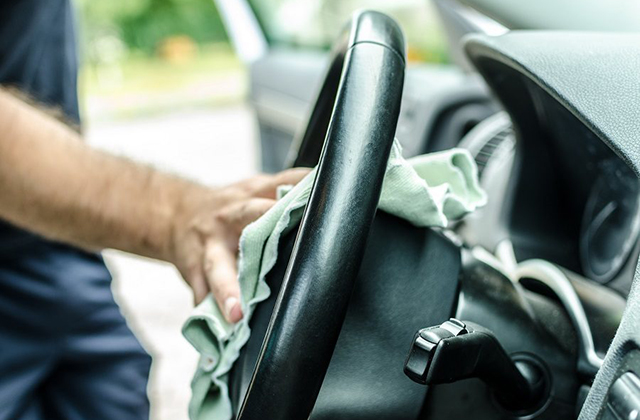Standard interior detailing involves many more types of materials and more complicated areas than standard exterior detailing (aside from major paint correction, of course). From personal experience, as well as the experience of several folks I’ve worked with, interior detailing takes longer than standard exterior detailing. It’s just more complicated. With car detailing companies you are getting more than an environmentally friendly, quality, auto detailing experience.
In fact, several operators surprisingly charge less for á la carte interior detailing, even though it takes more labor hours and equipment to perform. First tip: Examine how long it takes to perform an interior detail compared to an exterior detail before deciding on a price.
Tips and tricks of interior detailing will be covered in this article. For some operators, these might be standard operating procedures. Nonetheless, I hope everyone reading will find some of this content helpful.
Battling pet hair
Vacuuming and air purging the loose debris inside a car can be time consuming enough. If there is excessive pet hair, the job becomes particularly frustrating for the detailing technician. This is especially true if a vacuum and compressed air are the only equipment available.
The job of pet hair removal can be greatly improved with some kind of device or tool to help grab the pet hairs and pull them out of the carpet fibers. To that end, several small tools are available, including gloves with a special rubberized “hand,” a brush with rubber bristles, a rubbery pet hair sponge and the pumice block.
The typical technique is to “rake” the pet hair toward you with one of these devices in one hand and the hose end, preferably with a crevice tool for extra suction, in the other hand. As the pet hair is loosened by the raking motion, the vacuum sucks away the hair.
Although each of the mentioned tools will be very helpful with pet hair, the pumice block seems to be the most efficient and is preferred by many detailers. A disadvantage of the pumice block is that it will scratch hard plastic trim pieces which often surround carpeting. However, proper training and careful use, this should not be a problem.
Regardless of the tool selected to help remove pet hair, the amount of time spent will likely be reduced by 50 to 75 percent. This time savings doesn’t mean, however, that pet hair removal should be included in a standard interior detail. Remember, with removal of excessive pet hair, extra value is added to the detail job, which should bring up the price accordingly. In short, excessive pet hair is not part of a normal interior detail.
Cleaning carpets
A great way to deep clean carpets and mats is by using a hot water extractor. I recommend first vacuuming the carpets to remove loose dirt. Some technicians like to “dry scrub” the carpet first, which tends to loosen more dirt from the fibers.
After vacuuming, prespray the carpets with a non-foaming carpet cleaner that is designed for use with a hot water extractor. Then scrub the carpeting by hand or with a brush-equipped polisher. This scrubbing step will go far to improving the effectiveness of the extractor.
The heated water of a high-quality extractor should be enough to rinse the soil and cleaning chemical from the carpet. I don’t recommend adding any cleaner to the solution tank of the extractor. If you rinse with chemical-laden hot water, the carpet is infused with that chemical. The remaining chemical in the carpeting tends to attract dirt, making the carpets resoil much faster.
Carpets cleaned with extractors will require additional drying before returning to the customer. High-volume air movers can be used inside the car. Also, after moving the vehicle outside, the vehicle’s climate control system may be used to dry the carpet, utilizing both the heat and air conditioning (to remove moisture).
Lightly soiled carpets and mats can be successfully cleaned using the same techniques, only substituting a dry vapor steam machine for the extractor. The steam machine will effectively clean the top of the carpet fibers, leaving them clean, sanitized and virtually dry.
You’ve got to move it
Interior detailing is taking care of everything inside the car, including areas neglected by most drivers. So moving things around inside a car is necessary to get access to all those areas. This includes moving front seats to their extreme positions, adjusting them all the way up and all the way back. When the seats are moved, wipe off the seat tracks with a utility towel or a paper towel that can be discarded.
Make sure to clean between the front seats and the center console. This seems to be a universally common place customers inspect when picking up their “completed” vehicles. A towel wrapped around a spoke brush will help get into these hard-to-reach areas.
Many back seats nowadays are also moveable. Check to see if the seatbacks have a release, allowing them to fold forward. The crease area behind the seatback could have a collection of debris. Also, if the rear seat bottoms pull up or forward, move them as well, and clean the exposed area.
The rear section of an SUV often has several compartments under the floor. Check, vacuum and wipe these areas as necessary.
Stubborn marks
The hard plastic and vinyl surfaces inside the car are generally easy to clean with an all-purpose cleaner, brushes and microfiber towels to wipe away loosened grime. However, some marks on these surfaces will not come off with even the most aggressive brush.
At this point, I recommend having isopropyl alcohol available. With careful use, it will effectively remove shoe scuffs and similar marks. A popular foam pad cleaner or melamine block is also great for surface marks that don’t come off with normal cleaning.
Interior detailing is a complex operation requiring multiple steps that involve several chemicals and numerous pieces of equipment. Specialized tools, equipment, chemicals and techniques can help to make the job easier.

